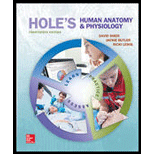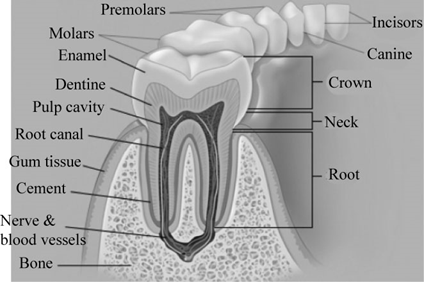
Hole's Human Anatomy & Physiology
14th Edition
ISBN: 9780078024290
Author: David N. Shier Dr., Jackie L. Butler, Ricki Lewis Dr.
Publisher: McGraw-Hill Education
expand_more
expand_more
format_list_bulleted
Question
Chapter 17, Problem 12CA
Summary Introduction
To describe:
The structure of tooth.
Introduction:
The teeth are the hardest portion in the body that involves two types of proteins Teeth is useful for the mechanical digestion of the food by their breakdown into smaller particles.
Teeth enable the mechanical digestion of food by breakdown of food into smaller pieces. Chewing of the food enables the interaction of the food to the digestive enzymes.
Pictorial representation:

Expert Solution & Answer
Want to see the full answer?
Check out a sample textbook solution
Students have asked these similar questions
Molecular Biology
A-C components of the question are corresponding to attached image labeled 1.
D component of the question is corresponding to attached image labeled 2.
For a eukaryotic mRNA, the sequences is as follows where AUGrepresents the start codon, the yellow is the Kozak sequence and (XXX) just represents any codonfor an amino acid (no stop codons here). G-cap and polyA tail are not shown
A. How long is the peptide produced?B. What is the function (a sentence) of the UAA highlighted in blue?C. If the sequence highlighted in blue were changed from UAA to UAG, how would that affecttranslation?
D. (1) The sequence highlighted in yellow above is moved to a new position indicated below. Howwould that affect translation? (2) How long would be the protein produced from this new mRNA?
Thank you
Molecular Biology
Question
Explain why the cell doesn’t need 61 tRNAs (one for each codon).
Please help. Thank you
Molecular Biology
You discover a disease causing mutation (indicated by the arrow) that alters splicing of its mRNA. This mutation (a base substitution in the splicing sequence) eliminates a 3’ splice site resulting in the inclusion of the second intron (I2) in the final mRNA. We are going to pretend that this intron is short having only 15 nucleotides (most introns are much longer so this is just to make things simple) with the following sequence shown below in bold. The ( ) indicate the reading frames in the exons; the included intron 2 sequences are in bold.
A. Would you expected this change to be harmful? ExplainB. If you were to do gene therapy to fix this problem, briefly explain what type of gene therapy youwould use to correct this.
Please help. Thank you
Chapter 17 Solutions
Hole's Human Anatomy & Physiology
Ch. 17 - Prob. 1PCh. 17 - 2 Which organs constitute the digestive system?
Ch. 17 - 3 Describe the wall of the alimentary canal.
Ch. 17 - Name the types of movements in the alimentary...Ch. 17 - Prob. 5PCh. 17 - Prob. 6PCh. 17 - How does the tongue function as part of the...Ch. 17 - Where are the tonsils located?Ch. 17 - Prob. 9PCh. 17 - How are types of teeth adapted to provide...
Ch. 17 - Prob. 11PCh. 17 - Explain how a tooth is attached to the bone of the...Ch. 17 - Prob. 13PCh. 17 - Prob. 14PCh. 17 - Prob. 15PCh. 17 - Prob. 16PCh. 17 - List the major events of swallowing.Ch. 17 - Prob. 18PCh. 17 - Prob. 19PCh. 17 - Prob. 20PCh. 17 - Why doesn’t the stomach digest itself?Ch. 17 - Prob. 22PCh. 17 - Distinguish among the cephalic, gastric, and...Ch. 17 - Prob. 24PCh. 17 - Prob. 25PCh. 17 - Prob. 26PCh. 17 - Prob. 27PCh. 17 - Prob. 28PCh. 17 - Prob. 29PCh. 17 - List the enzymes in pancreatic juice.Ch. 17 - What are the functions of the enzymes in...Ch. 17 - What regulates secretion of pancreatic juice?Ch. 17 - Locate the liver.Ch. 17 - Review liver functions.Ch. 17 - Prob. 35PCh. 17 - Prob. 36PCh. 17 - Describe the function of the gallbladder.Ch. 17 - How is secretion of bile regulated?Ch. 17 - Prob. 39PCh. 17 - Describe the parts of the small intestine.Ch. 17 - What is the function of an intestinal villus?Ch. 17 - Prob. 42PCh. 17 - Prob. 43PCh. 17 - Prob. 44PCh. 17 - Prob. 45PCh. 17 - Prob. 46PCh. 17 - Prob. 47PCh. 17 - Prob. 48PCh. 17 - Prob. 49PCh. 17 - What stimulus relaxes the ileocecal sphincter?Ch. 17 - Prob. 51PCh. 17 - Prob. 52PCh. 17 - Prob. 53PCh. 17 - Prob. 54PCh. 17 - Prob. 55PCh. 17 - Prob. 56PCh. 17 - Prob. 57PCh. 17 - Prob. 58PCh. 17 - Prob. 59PCh. 17 - Prob. 60PCh. 17 - Prob. 61PCh. 17 - Prob. 1CACh. 17 - Prob. 2CACh. 17 - Prob. 3CACh. 17 - Prob. 4CACh. 17 - Prob. 5CACh. 17 - Prob. 6CACh. 17 - Prob. 7CACh. 17 - Prob. 8CACh. 17 - Prob. 9CACh. 17 - Prob. 10CACh. 17 - Prob. 11CACh. 17 - Prob. 12CACh. 17 - Prob. 13CACh. 17 - Prob. 14CACh. 17 - Describe the locations of the major salivary...Ch. 17 - Prob. 16CACh. 17 - Prob. 17CACh. 17 - Prob. 18CACh. 17 - Prob. 19CACh. 17 - Prob. 20CACh. 17 - Prob. 21CACh. 17 - Prob. 22CACh. 17 - Prob. 23CACh. 17 - Prob. 24CACh. 17 - Prob. 25CACh. 17 - Prob. 26CACh. 17 - Prob. 27CACh. 17 - Prob. 28CACh. 17 - Prob. 29CACh. 17 - Prob. 30CACh. 17 - Prob. 31CACh. 17 - Prob. 32CACh. 17 - Prob. 33CACh. 17 - Prob. 34CACh. 17 - Describe the locations of the parts of the small...Ch. 17 - Prob. 36CACh. 17 - Prob. 37CACh. 17 - Prob. 38CACh. 17 - Prob. 39CACh. 17 - Prob. 40CACh. 17 - Prob. 41CACh. 17 - Prob. 42CACh. 17 - Prob. 43CACh. 17 - Prob. 44CACh. 17 - Prob. 45CACh. 17 - Prob. 46CACh. 17 - Prob. 1IACh. 17 - Prob. 2IACh. 17 - What effect is a before-dinner alcoholic cocktail...Ch. 17 - What type of acid-base imbalance is likely to...Ch. 17 - Prob. 5IA
Knowledge Booster
Learn more about
Need a deep-dive on the concept behind this application? Look no further. Learn more about this topic, biology and related others by exploring similar questions and additional content below.Similar questions
- Molecular Biology Question Please help. Thank you Explain what is meant by the term “defective virus.” Explain how a defective virus is able to replicate.arrow_forwardMolecular Biology Explain why changing the codon GGG to GGA should not be harmful. Please help . Thank youarrow_forwardStage Percent Time in Hours Interphase .60 14.4 Prophase .20 4.8 Metaphase .10 2.4 Anaphase .06 1.44 Telophase .03 .72 Cytukinesis .01 .24 Can you summarize the results in the chart and explain which phases are faster and why the slower ones are slow?arrow_forward
- Can you circle a cell in the different stages of mitosis? 1.prophase 2.metaphase 3.anaphase 4.telophase 5.cytokinesisarrow_forwardWhich microbe does not live part of its lifecycle outside humans? A. Toxoplasma gondii B. Cytomegalovirus C. Francisella tularensis D. Plasmodium falciparum explain your answer thoroughly.arrow_forwardSelect all of the following that the ablation (knockout) or ectopoic expression (gain of function) of Hox can contribute to. Another set of wings in the fruit fly, duplication of fingernails, ectopic ears in mice, excess feathers in duck/quail chimeras, and homeosis of segment 2 to jaw in Hox2a mutantsarrow_forward
- Select all of the following that changes in the MC1R gene can lead to: Changes in spots/stripes in lizards, changes in coat coloration in mice, ectopic ear formation in Siberian hamsters, and red hair in humansarrow_forwardPleiotropic genes are genes that (blank) Cause a swapping of organs/structures, are the result of duplicated sets of chromosomes, never produce protein products, and have more than one purpose/functionarrow_forwardA loss of function mutation in Pitx1 enhancers can cause (blank) Removal of Pitx1 exons and growth of ectopic hindlimbs, growth of extra ectopic forelimbs, loss of forelimb specification and development, and loss of hindlimb specification and developmentarrow_forward
- Hox1a most likely contributes to (blank) patterning in the developing embryo? Ventral, posterior, limb or anteriorarrow_forwardSelect all of the following that can help establish Hox gene expression boundaries (things that affect Hox and not things that Hox affects). Retinoic acid, anterior/posterior axis, fibroblast growth factors, vagal neural crest, and enhancersarrow_forwardEctopic expression of Hox often results in (blank) phenotypes. (Blank) transformations are characterized by the replacement of one body part/structure with another. Hoxeotic, homealoneotic, joexotic, or homeoticarrow_forward
arrow_back_ios
SEE MORE QUESTIONS
arrow_forward_ios
Recommended textbooks for you
 Human Anatomy & Physiology (11th Edition)BiologyISBN:9780134580999Author:Elaine N. Marieb, Katja N. HoehnPublisher:PEARSON
Human Anatomy & Physiology (11th Edition)BiologyISBN:9780134580999Author:Elaine N. Marieb, Katja N. HoehnPublisher:PEARSON Biology 2eBiologyISBN:9781947172517Author:Matthew Douglas, Jung Choi, Mary Ann ClarkPublisher:OpenStax
Biology 2eBiologyISBN:9781947172517Author:Matthew Douglas, Jung Choi, Mary Ann ClarkPublisher:OpenStax Anatomy & PhysiologyBiologyISBN:9781259398629Author:McKinley, Michael P., O'loughlin, Valerie Dean, Bidle, Theresa StouterPublisher:Mcgraw Hill Education,
Anatomy & PhysiologyBiologyISBN:9781259398629Author:McKinley, Michael P., O'loughlin, Valerie Dean, Bidle, Theresa StouterPublisher:Mcgraw Hill Education, Molecular Biology of the Cell (Sixth Edition)BiologyISBN:9780815344322Author:Bruce Alberts, Alexander D. Johnson, Julian Lewis, David Morgan, Martin Raff, Keith Roberts, Peter WalterPublisher:W. W. Norton & Company
Molecular Biology of the Cell (Sixth Edition)BiologyISBN:9780815344322Author:Bruce Alberts, Alexander D. Johnson, Julian Lewis, David Morgan, Martin Raff, Keith Roberts, Peter WalterPublisher:W. W. Norton & Company Laboratory Manual For Human Anatomy & PhysiologyBiologyISBN:9781260159363Author:Martin, Terry R., Prentice-craver, CynthiaPublisher:McGraw-Hill Publishing Co.
Laboratory Manual For Human Anatomy & PhysiologyBiologyISBN:9781260159363Author:Martin, Terry R., Prentice-craver, CynthiaPublisher:McGraw-Hill Publishing Co. Inquiry Into Life (16th Edition)BiologyISBN:9781260231700Author:Sylvia S. Mader, Michael WindelspechtPublisher:McGraw Hill Education
Inquiry Into Life (16th Edition)BiologyISBN:9781260231700Author:Sylvia S. Mader, Michael WindelspechtPublisher:McGraw Hill Education

Human Anatomy & Physiology (11th Edition)
Biology
ISBN:9780134580999
Author:Elaine N. Marieb, Katja N. Hoehn
Publisher:PEARSON

Biology 2e
Biology
ISBN:9781947172517
Author:Matthew Douglas, Jung Choi, Mary Ann Clark
Publisher:OpenStax

Anatomy & Physiology
Biology
ISBN:9781259398629
Author:McKinley, Michael P., O'loughlin, Valerie Dean, Bidle, Theresa Stouter
Publisher:Mcgraw Hill Education,

Molecular Biology of the Cell (Sixth Edition)
Biology
ISBN:9780815344322
Author:Bruce Alberts, Alexander D. Johnson, Julian Lewis, David Morgan, Martin Raff, Keith Roberts, Peter Walter
Publisher:W. W. Norton & Company

Laboratory Manual For Human Anatomy & Physiology
Biology
ISBN:9781260159363
Author:Martin, Terry R., Prentice-craver, Cynthia
Publisher:McGraw-Hill Publishing Co.

Inquiry Into Life (16th Edition)
Biology
ISBN:9781260231700
Author:Sylvia S. Mader, Michael Windelspecht
Publisher:McGraw Hill Education
Complications during Labour and Delivery; Author: FirstCry Parenting;https://www.youtube.com/watch?v=QnCviG4GpYg;License: Standard YouTube License, CC-BY